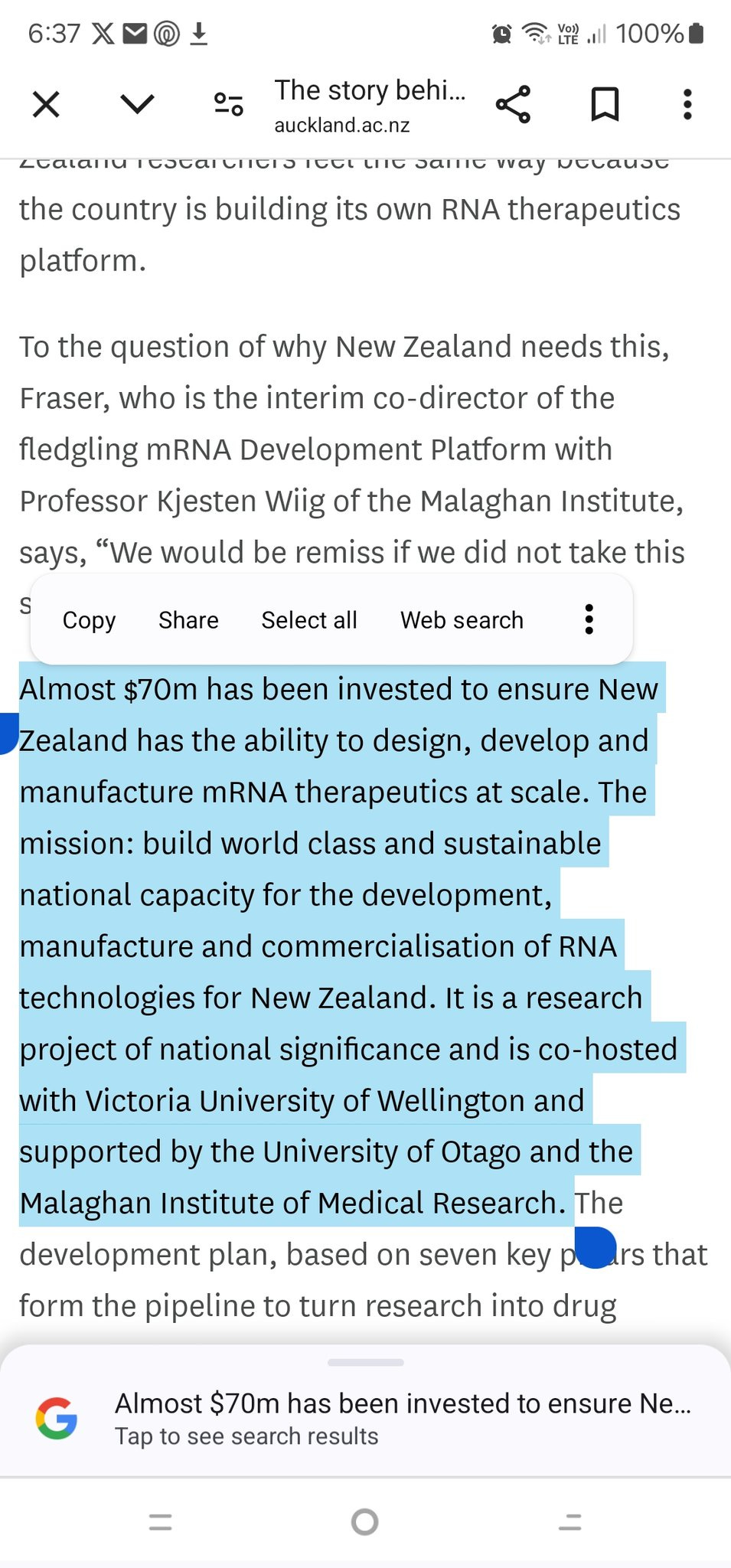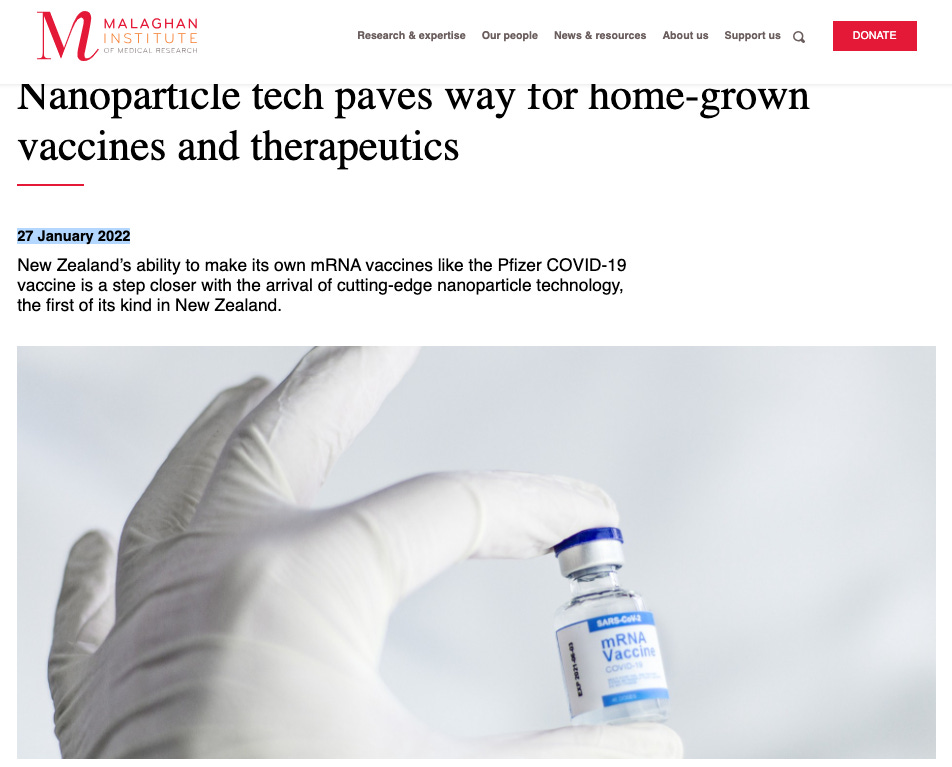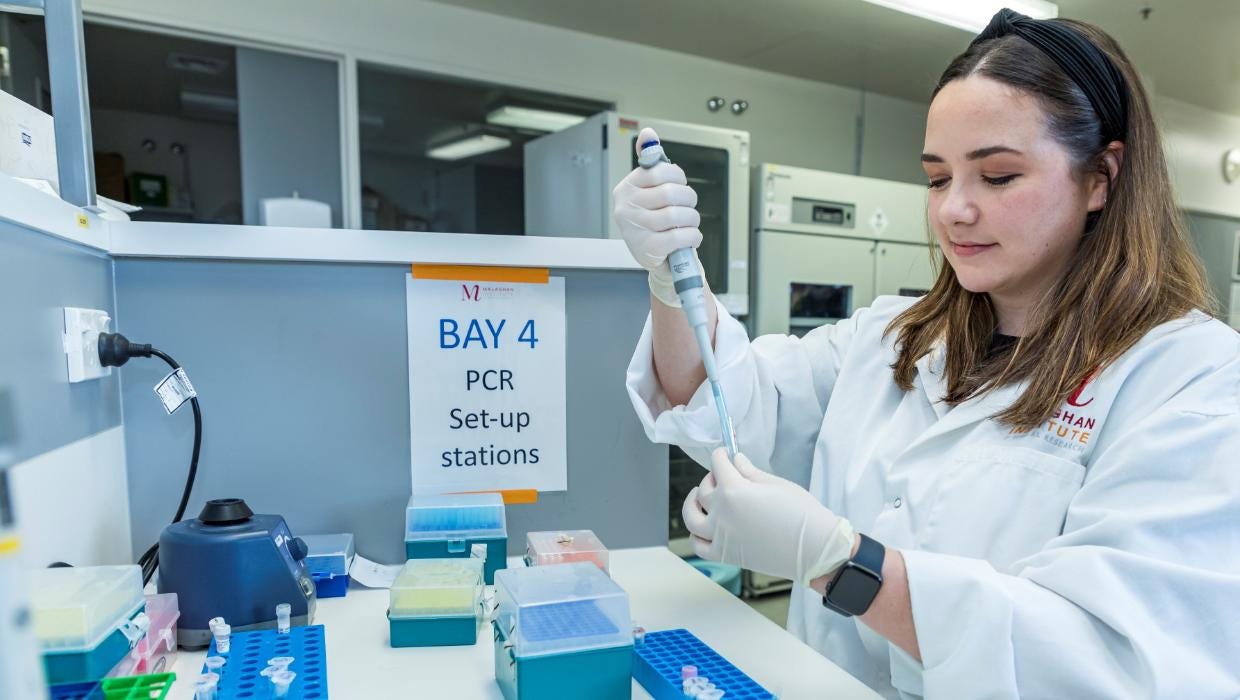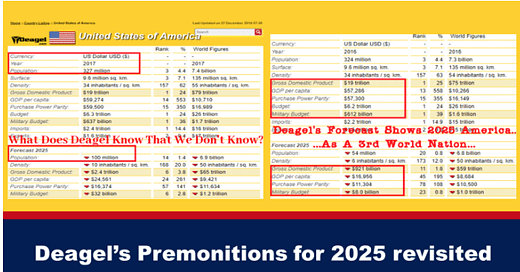
NZ government invests $70 MILLION to develop killer mRNA shot
Could THIS be a significant reason NZ MP's remain silent about mRNA harm and the media refuses to investigate?
All I knew of all this is a small article mentioning that a biotech company in Timaru was going to be developing mRNA “vaccines”
Lynda Wharton of NZ and the MRNA writes:
NZ FULLY INVESTED IN JOINING THE MRNA GOLD RUSH....
Could THIS be a significant reason NZ MP's remain silent about mRNA harm....and NZ mainstream media refuses to investigate harms from the Pfizer Covid injections?
The NZ government has already invested $70 MILLION to ensure NZ has the ability to:
Design
Develop
Manufacture MRNA
NZ researchers are already working to develop our own mRNA platform.
The mission:
build world class and sustainable national capacity for the development, manufacture and commercialisation of RNA technologies for New Zealand.
It is a research project of national significance and is co-hosted with Victoria University of Wellington and supported by the University of Otago and the Malaghan Institute of Medical Research
To the question of why New Zealand needs this, Fraser, who is the interim co-director of the fledgling mRNA Development Platform with Professor Kjesten Wiig of the Malaghan Institute, says, “We would be remiss if we did not take this step.”
For Fraser and the Government, the platform is insurance.
Just as valuable, says Fraser, is that the RNA platform will drive new skills and support laboratory and manufacturing facilities so New Zealand can map out its own place in this revolutionary new frontier of medicine and therapeutics.
Fraser says, “The potential is that you can put a gene for anything inside our cells and the cells become the bioreactors. It opens up a whole new field.” In the near future foundations will be laid for a PRODUCTION FACILITY to manufacture new therapies at scale.
Fraser is not one to speculate.
But he is confident that New Zealand will gain great benefits by joining the global mRNA technology push.
“Within seven years, the mRNA platform will be operating, and I would expect to see a number of homegrown therapeutics and clinical trials underway.”
Here is the quoted article from the University of Auckland
The story behind New Zealand's mRNA platform
3 October 2023
The University is the co-lead of a project of national significance to build a mRNA plaform to spark the next revolution in medical science and healthcare.
If a pandemic can be said to have a bright side, then the Covid-19 virus that swept the world, crippling economies and dividing societies, did deliver one shining example of the ingenuity of humanity. Covid-19 vaccines were developed at a speed never seen before and they worked.
The best estimates of global deaths in the pandemic by the World Health Organisation suggest an excess mortality due to Covid of at least three million. It could have been far worse. Researchers at Imperial College, London, have estimated that the Covid-19 vaccines saved 19.8 million lives in one year alone, from December 2020 to 2021.
Professor John Fraser, Dean of the Faculty of Medical and Health Sciences says, “It is difficult to contemplate what would have happened to the world if a treatment, one with 95% efficacy, had not been developed.” Consider the impact that continues to this day, he says.
Some 70.5% of humanity has received one dose of the Covid-19 vaccines, with 13.5 billion doses administered globally. The most common vaccines, those developed by Pfizer-BioNtech and Moderna, were mRNA vaccines, the first to be approved by the Federal Drug Administration. The speed at which those vaccines were developed has become legendary. The Pfizer-BioNtech vaccine, the predominant choice in New Zealand, was ready for clinical trial in 68 days. New drugs traditionally take decades to develop, trial and bring to market.
Partly this was because of the billions invested at a time of urgent global crisis, but it was also because the mRNA techniques enable far faster development while also opening up new approaches for medical treatments. Across the world clinicians and researchers are excited about how potential new treatments for autoimmune conditions, cancer and genetic diseases. New Zealand researchers feel the same way because the country is building its own RNA therapeutics platform.
To the question of why New Zealand needs this, Fraser, who is the interim co-director of the fledgling mRNA Development Platform with Professor Kjesten Wiig of the Malaghan Institute, says, “We would be remiss if we did not take this step.”
Almost $70m has been invested to ensure New Zealand has the ability to design, develop and manufacture mRNA therapeutics at scale. The mission: build world class and sustainable national capacity for the development, manufacture and commercialisation of RNA technologies for New Zealand. It is a research project of national significance and is co-hosted with Victoria University of Wellington and supported by the University of Otago and the Malaghan Institute of Medical Research. The development plan, based on seven key pillars that form the pipeline to turn research into drug development, clinical testing and manufacture at an industrial scale has been signed off.
Airfinity a UK based disease forecasting consultancy assessed the likelihood of future pandemics as deadly as Covid 19 at 27.5% in the 10 years to 2033.
For Fraser and the Government, the platform is insurance. In April, Airfinity, a UK based disease forecasting consultancy, assessed the likelihood of future pandemics as deadly as Covid 19 at 27.5% in the 10 years to 2033.
The firm’s worst-case scenario describes an avian flu type mutation that transmits between humans and could kill as many as 15,000 people a day in the United Kingdom. The unpalatable scenario changes dramatically if effective vaccines can be rolled out within 100 days after discovery of a new pathogen, reducing the risk to 8.1%.
Fraser says, “The Government is rightly keen to have the capacity to develop RNA technology to a point where should we be faced with another crisis, New Zealand would have the ability to develop our own response.”
In the early days of the pandemic, he recalls the worry he felt about the place New Zealand would be in the queue for vaccines. At the time he wondered whether Pfizer and others would be able to marshal the knowhow and resources to manufacture the billions of doses the world required.
The desperation of early 2020 is easily forgotten, he says. Cargo planes were hastily chartered, officials intercepted containers of PPE passing through ports. Health officials all over the globe held tense late-night negotiations with the future of their nation’s people at stake. Fraser:“We might not be so fortunate in the future.”
Insurance is a good reason but not the only one. Just as valuable, says Fraser, is that the RNA platform will drive new skills and support laboratory and manufacturing facilities so New Zealand can map out its own place in this revolutionary new frontier of medicine and therapeutics.
Fraser says, “The potential is that you can put a gene for anything inside our cells and the cells become the bioreactors. It opens up a whole new field.”
Bioreactor is a reference to how vaccines are traditionally seeded in eggs to grow the quantities required for mass vaccination programmes. RNA technology sidesteps what have been complicated and costly steps to develop and manufacture vaccines and other medicines at scale. (See: Explainer: mRNA technology in three acts)
A further reason for New Zealand to have a homegrown RNA platform is that researchers can focus on what matters to us. “It’s too early to say right now, and we’re not pinning ourselves to any specific disease, but, of course, I have my favourite ones. What we will do is look at diseases that are most relevant to us, that the rest of the world is not doing.”
A likely candidate would be the influenza vaccine. Each year there is a new iteration of the flu vaccine, based on the most common strain in the northern hemisphere. Sufficient quantities of the candidate vaccine are then grown in eggs. As the southern hemisphere winter descends New Zealand begins its annual flu vaccine campaign.
What we do now is ‘crude and primitive’ says Fraser. The flu virus is sequenced, deactivated and then manufactured. But sometimes the researchers get the variant wrong. There’s antigenic drift as the flu strain mutates in hundreds of millions of people.
It can mean that once it arrives in New Zealand, the flu has become a different strain. In which case the northern hemisphere flu vaccine concocted six months previously becomes almost useless. Even in a best-case scenario the flu vaccine is only about 50% effective.
The scientific consensus is that it is only a matter of when not if, for the next pandemic. It could be another coronavirus or a particularly severe influenza. The 1918 influenza pandemic was a bigger killer than Covid and researchers like Fraser can easily offer far worse scenarios that are well within the bounds of possibility.
The mRNA platform opens up research areas beyond vaccines. A promising field is CAR T-cell therapies, developed to treat a number of blood cancers. Here T-cells, white blood cells that fight infection and disease are collected from a patient and engineered to recognise and attack the antigens, a specific protein found on cancer cells. A successful mRNA CAR T-cell therapy would not require the harvest of T-cells, speeding up the process and cutting the cost. Overseas researchers are looking to use mRNA technology to develop monoclonal antibodies, a targeted drug therapy to help the body develop the immune system to fight cancer and autoimmune diseases.
“Within seven years, the mRNA platform will be operating, and I would expect to see a number of homegrown therapeutics and clinical trials underway.”
Professor John FraserCo-Director, mRNA Platform
A further tool offered by RNA is that it can be used to ‘silence’ genes, allowing researchers to target genes associated with disease.
At Auckland City Hospital, Professor Ed Gane of FMHS led a successful human clinical trial with a therapy known as the CRISPR/Cas9 mRNA nanoparticle. The therapy is designed to silence the gene leading to the fatal disease amyloidosis, where liver cells produce an abnormal protein that leads to damage in the heart, nervous system and the gut. Once those who inherit the gene become adults, the symptoms appear with the condition usually fatal within 10 years. Early results suggest that the gene therapy is a success.
The mRNA platform is in its earliest days. There is infrastructure to plan and research networks and collaborations to be established, nationally and internationally. In the near future foundations will be laid for a production facility to manufacture new therapies at scale. Fraser is not one to speculate. But he is confident that New Zealand will gain great benefits by joining the global mRNA technology push. “Within seven years, the mRNA platform will be operating, and I would expect to see a number of homegrown therapeutics and clinical trials underway.”…. [ ]
****
Here are some other articles I have been able to find.
27 January 2022
The NanoAssemblr Blaze is designed to produce lipid nanoparticles to encapsulate mRNA to safely deliver it to cells – the scientific breakthrough that thrust mRNA vaccines to the fore at the start of the COVID-19 pandemic.
Funded by private donors to the Malaghan Institute of Medical Research, the $1m Blaze landed in Timaru this month where it is being installed at South Pacific Sera, a biotech that is part of Vaccine Alliance Aotearoa New Zealand – Ohu Kaupare Huaketo (VAANZ).
Professor Graham Le Gros, Director of the Malaghan Institute and VAANZ Programme Director, says the arrival of the technology marks a significant step towards New Zealand producing its own mRNA vaccines and other RNA therapeutics in the future.
“The Blaze will allow us to bridge the gap between lab research and clinical development. It is just the start of the RNA nanomedicine pipeline we envisage for New Zealand – to translate mRNA and RNA research and development into homegrown vaccines and therapeutics.”
He says having an end-to-end mRNA platform in New Zealand would provide vaccine security and enable a rapid response to future pandemics, something VAANZ has been focused on since it was first funded by the Government in 2020 to lead COVID-19 vaccine research in Zealand.
“VAANZ’s goal is to build New Zealand’s capability and platforms for vaccine development to meet the current and future demands of infectious disease threats.”
South Pacific Sera Production Director Dr William Rolleston says the Blaze will allow South Pacific Sera to develop the process of encapsulating mRNA vaccines, a critical component for mRNA vaccine manufacture.
“mRNA encapsulation adds new capability to South Pacific Sera’s GMP vaccine manufacturing infrastructure. With the Blaze installed and ready to go we will have the opportunity to use our knowledge and experience to develop local GMP manufacturing solutions to meet the challenge of mRNA vaccine production.
“COVID-19 vaccines are just the tip of the iceberg for what this technology offers, with enormous potential for therapeutic development not just for human medicine but also across the primary sector.”
Professor Le Gros says the Blaze will first be put to use on a pilot mRNA COVID-19 vaccine VAANZ has under development, based on its recombinant spike protein vaccine candidate that is being developed in parallel and is currently completing preclinical development.
“VAANZ’s aim is to take this COVID-19 mRNA vaccine candidate into human clinical trials, to develop local capability and inform how we build New Zealand’s mRNA infrastructure.
“This is a real opportunity to build the know-how and infrastructure for future mRNA vaccine development and GMP production capacity in New Zealand. It’s about laying the foundations so that we’re ready and responsive for future pandemics.”
January 27, 2022
New Zealand one step closer to producing own mRNA vaccine
A Timaru bio-tech company, and its research partners, are another step closer to New Zealand producing its own mRNA vaccines after the arrival of a $1 million machine – the first of its kind in the country.
Minister of Research, Science and Innovation, Dr Megan Woods, said at the launch of the machine at South Pacific Sera, in Washdyke, on Thursday it was “fantastic" to see the Government’s investment and research community and industry sector come together to get opportunities for New Zealand.
“It is satisfying and inspiring,’’ Wood said.
“It’s fantastic to see. I’m not surprised this is in Timaru [the machine]. South Pacific Sera has built its core strength in animal vaccines. New Zealand has amazing vaccination capability and has been a world leader in animal vaccinations.”
May 26, 2022
Timaru biotech company pleased the Government is investing in RNA technology and development
A South Canterbury biotechnology company working towards being the first in New Zealand to manufacture a Covid-19 vaccine is pleased to see the Government investing in biotechnology infrastructure.
Dr William Rolleston co-founder and co-director of South Pacific Sera said believes the funding for RNA technology and development in the Budget is a step in the right direction
In January Rolleston told Stuff New Zealand is one step closer to producing its own mRNA vaccine with the arrival of the NanoAssembler Blaze which is a machine that produces lipid nanoparticles (microscopic balls of fat) to protect mRNA (messenger ribonucleic acid) which is genetic material used in vaccines, clinical medicines and research.
The $1 million machine has been funded by private donors to the Malaghan Institute of Medical Research, a biomedical research institute that is part of the Vaccine Alliance Aotearoa New Zealand – Ohu Kaupare Huaketo (Vaanz).
March 10, 2024
Here is the company which plays on “pristine NZ” to produce a killer poison
https://www.southpacificsera.co.nz/
Whatever happened to the Kiwi Covid vaccine?
Four years into the pandemic, New Zealand is still trying to produce a Covid-19 vaccine. Nikki Macdonald asks what’s the point, and whether designing and manufacturing vaccines is a pipe-dream for a tiny country at the end of the earth.
In October 2021, Malaghan Institute boss Professor Graham Le Gros predicted a Kiwi-designed and produced Covid vaccine would be tested on people by October 2022. That didn’t happen.
In March 2023, the Vaccine Alliance said the first of three phases of clinical trials would now start in September 2023. But September came and went, and six months on, there’s still no trial.
The project was part of the $10 million Vaccine Alliance Aotearoa NZ (VAANZ) - a colab set up by the Government to evaluate overseas vaccines as they became available, and to kickstart New Zealand research in case we couldn’t buy any.
The alliance did produce a Covid jab that worked. But the stalled progress since is a reminder that design is only one thread of the complex and expensive web of testing, manufacturing and approval needed before a vaccine gets anywhere near human arms.
It’s only the second time a New Zealand company has applied to medicines regulator Medsafe for a licence to make vaccines, so it’s a slow process breaking new ground.
But VAANZ now concedes it would need a “magic fairy” funder to ever get the vaccine to market. So why are we still bothering? And what does the inching progress say about New Zealand’s aspirations to make its own vaccines? ….
Run by brothers William and John Rolleston, South Pacific Sera has been quietly making animal products for biotech for 35 years.
“People come down to Timaru with a fairly sceptical view, and go back with their jaws on the floor and eyes wide open, and we quite enjoy that,” says William Rolleston, who is a medical doctor.
Over the past two years, the company has employed a team of scientists to turn Malaghan’s lab-based production process into something scaleable. It’s trickier than it might sound, given Kiwi Vax is not an mRNA vaccine but a more traditional vaccine that requires growing cells.
And for about the past six months, they’ve been working with Medsafe to get approval to make Kiwi Vax for human use.
“It’s been a big job for us, and the regulators too, I think,” Rolleston says.
He says Medsafe is being “thorough but not obstructive”.
Medsafe group manager Chris James can’t predict how long the approval process might take.
Like all companies making medical products, South Pacific Sera already meets tough Good Manufacturing Practice (GMP) standards. But because vaccines are higher risk, they carry even more stringent requirements.
The company also has to get licensed, and then the vaccine itself has to get the tick for general use.
“Both licensing of a manufacturing site and product approval are highly dependent on the readiness of the manufacturer and on the data that has been submitted,” James says. “Medsafe would consider prioritising vaccines where there was a greater need.”
A slow process isn’t necessarily fatal. The year it took for the world to design, make and distribute Covid vaccines was considered breakneck speed.
But four years into a waning pandemic, when the world already has effective Covid vaccines with established manufacturing, approval and supply networks, what is the point of New Zealand pushing on?
Why bother continuing?
While VAANZ previously said its vaccine could be useful in the Pacific, because it’s easier to store, they now concede it’s unlikely to ever get to market.
VAANZ executive director and Malaghan Institute professor, Kjesten Wiig, reckons the project has probably cost more than $10m so far. That’s also how much VAANZ got from the Government way back in 2020.
A Phase I safety trial would cost another $1.5m-$2.5m; a Phase II trial would be another $15m, and a Phase III trial another $40m.
While it’s understood philanthropists will fund Phase I safety testing, Wiig says getting the vaccine through all the testing and approvals would require a “magic fairy” funder.
And even if they could do all that, and their vaccine proved better than what’s already out there, the market is so tied up by existing large pharmaceutical companies, they would struggle to sell it, she concedes.
“I think that a tiny little outfit from New Zealand would have not that much success competing with them ... for a global market share.”



















Oh how the unicorn dreams of genetic transformation and wildly imagined possibilities to unlock biological evolution via simple -- only $70 mil! -- and easy-as CRISPR tinkering mixed with 'normalised' mass experimentation that are a Save & Effective® solution to most _all_ diseases!
But wait, that was way back in 2022, right?! With WWIII happening, we might have to stick to practical weaponization for a few years/decades...